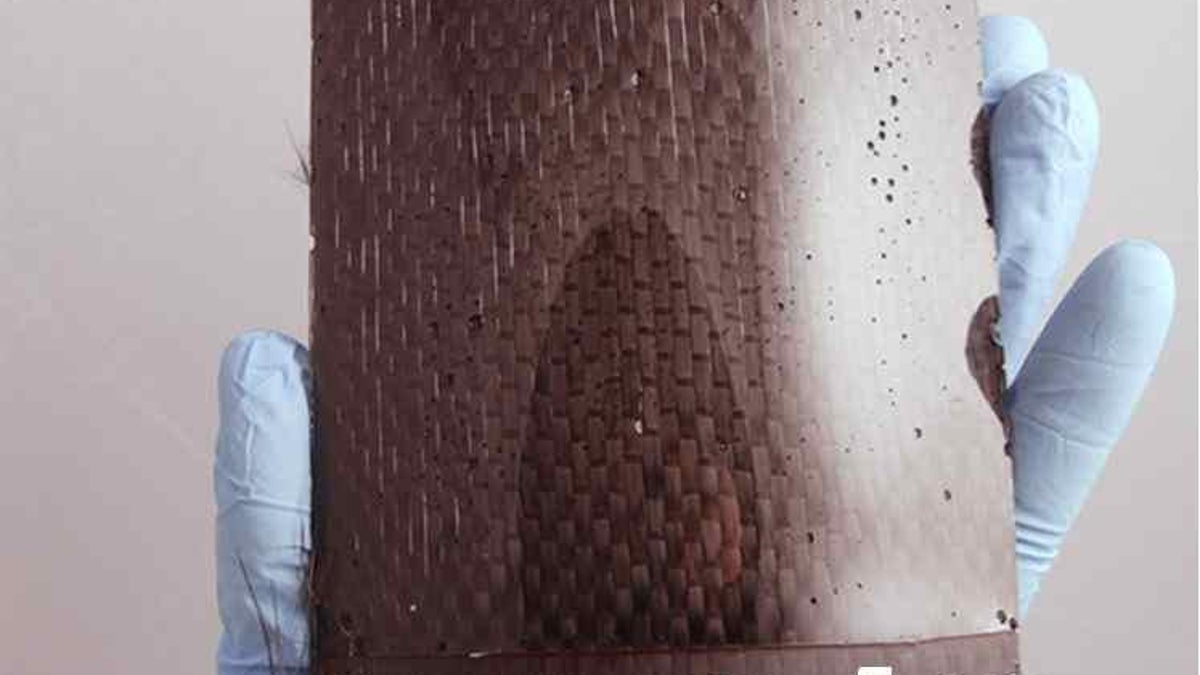The holy grail of adhesives?
A gecko-inspired adhesive from a University of Massachusetts research team can hold up to 700 pounds on a sheet the size of an index card.

UMass is not the first institution to look to the gecko and its remarkable powers of adhesion. A team from Berkeley announced a gecko-inspired nonskid surface back in 2006. "I can list maybe 20 other people" heading up similar work, says UMass researcher Al Crosby.
Most of that work, however, has focused on the hair on the bottom of the gecko's feet. Called setae, these hairs are only part of the reason why the gecko, among other species, can use adhesion to move along walls and ceilings.
"In order for something this large to use adhesion," Crosby says, "its tendons are stitched right into its skin. And so you have the tendon, which is very stiff tissue, connected to the skin and the setae. That direct connection is critical. Without that, the gecko could not use adhesion. This direct integration is what we ended up mimicking in Geckskin.
"What we really wanted to focus on is scaling up the properties and attributes that a gecko displays," he says. "Being able to sustain a high load on a vertical or overhanging surface. To release that upon command with minimal force. And to be able to do this over and over and over again with minimal energy loss.
"These are the attributes that we focused on and we found that this skin tendon connection was really one of the most enabling features," he says.
The properties of the resulting Geckskin technology could hold huge, industry-disrupting potential.
Via a UMass press release, "Our Geckskin device is about 16 inches square, about the size of an index card, and can hold a maximum force of about 700 pounds while adhering to a smooth surface such as glass."
Geckskin leaves no sticky residue when you peel it off, and it's also reusable. How many times can you reapply one sheet of Geckskin? "Hundreds, at least," Crosby says. "We have measured this without seeing any degradation in performance." He says the reality is probably in the thousands.
And while the paper Crosby, UMass doctoral candidate Michael Bartlett, biologist Duncan Irschick, and others published in the journal "Advanced Materials" documents only data for using Geckskin on glass, Crosby says his team has also successfully tested the material on other surfaces like metal, wood, and drywall.
Still in question is the length of time that Geckskin can maintain its grip. Crosby donated his own 42-inch flat-panel television for a duration test, in which his assistants watched a full-length baseball game. A 3-hour stint is impressive, but that's not exactly enough data to up-end the television wall-mounting market.
"We've had something hang for several months," Crosby says. "In terms of hanging something that's 100 pounds [for an extended duration], we just haven't done that testing yet. Some of that is beyond the kind of testing that a university is going to do and it's going to be up to whoever is going to commercialize this. We've hung objects long enough that we're quite confident in Geckskin, but we just don't know the limits."
Is it conceivable that a theoretical Geckskin wall mount would support a television for 10 years? "I think that we can reach that," Crosby says, "but it's still in research."
Crosby isn't naming the companies that might commercialize Geckskin because of ongoing negotiations. He says among them are "certain large companies that most people would recognize as being interested in a product like this."
For an idea of what companies those might be, you might look to the Adhesive and Sealant Council (ASC), an industry trade group that counts 3M, Dow Chemical, Avery Dennison, and Illinois Tool Works among its membership.
"The concept behind the gecko is kind of the holy grail of adhesives," says ASC president Matt Croson. "It's a small animal that can hold a lot of weight." Croson also pointed to the gecko's ability to seemingly turn its adhesion powers on and off. "It sticks, and then it doesn't." Adhesion scientists find those characteristics very appealing.
In addition to large corporate partners, Crosby has also been in touch with private investors interested in Geckskin. "They are looking at this as opening new markets. It has a lot of properties that are just not seen in today's materials, so it's kind of fun." Asked what that properties might be, Crosby declined to elaborate, citing the ongoing discussions.
Crosby is also unsure how much a consumer might pay for a Geckskin product, but it doesn't sound like it will be that expensive to manufacture. "Right now we estimate that at least the materials costs are under 25 cents for a pad to hold something about 700 pounds. That's small scale production, but not including labor."
The 700-pound capacity design is constructed with materials like carbon fiber and Kevlar. Crosby says they also have a design using more affordable nylon like that used in a school backpack.
"The materials that this technology works with are things that are found in bathroom caulking and things that we found at Jo-Ann Fabrics. Now the things that we found at Jo-Ann Fabrics can hold 200 to 300 pounds. It doesn't hold 700 pounds. But still, a 200-pound [capacity] pad with something you can buy at Target isn't bad."
So when will you be able to purchase a Geckskin product?
"We're marching along. We would hope that there would be some kind of product or commercial application by the end of next year. In terms of whether you see it hanging a 42-inch TV by next year, that's unlikely. There's going to have to be more testing for duration. But for certain products I think it can come out pretty quickly. It holds with pretty good confidence from what we've seen."

